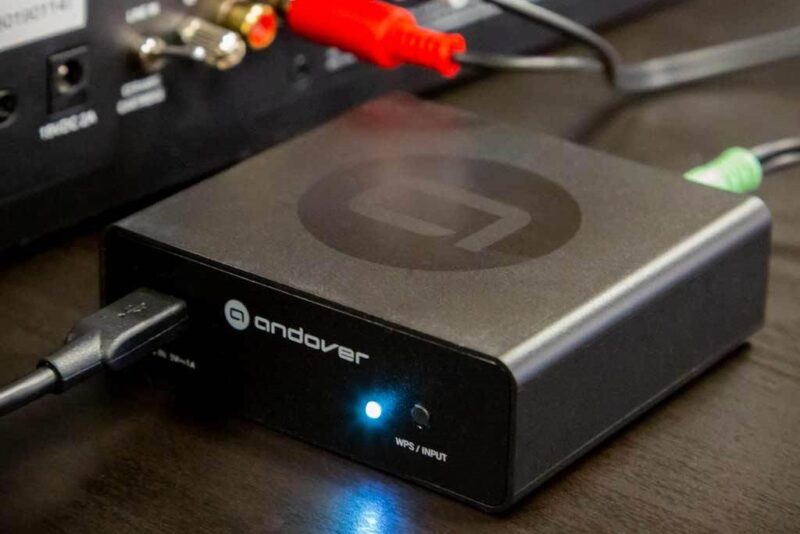This simple music streamer gives you a whole lotta music for just a little bit of dough…
I’ll say it. I’m crazy about Andover Audio. They’ve put out some sensational gear over the last couple of years. I really liked their SpinBase Turntable Speaker System ($299) so much I made it our Product of The Year for 2020. By the way, the companion SpinDeck Turntable (also $299) is a nice match for that remarkable powered speaker.
The new $149 Songbird Music Streamer is marketed as another source option for the SpinBase. However, it’s actually a great budget streamer for anyone who wants to bring high-quality network audio to their hi-fi system.
This affordable, compact device has both digital and analog outputs that will connect to any component, plus it streams all the major music services (TIDAL, Qobuz, Spotify). It also streams files from a network drive, Apple Airplay, or Bluetooth. It also sounds excellent, which makes it a great value. It’s available right now over on the Andover Audio website, as well as Amazon.
Disclaimer: The Songbird was sent to us by Andover Audio in exchange for our honest opinion.
What we love: The Songbird is super-compact (H:3.25″ W: 3.41″ D: 1.02″), which means you can stash it in any tight space. As I said before, it was originally designed to work with Andover Audio’s SpinBase, and if you purchase the matching Spinstand, they also provide a piece of velcro to attach to the stand.
This will help keep it out of the way if space is tight, and there’s no reason it can’t be used with any audio stand.
The Songbird also has a nice compliment of connections for such a compact unit, boasting optical digital ins and outs, plus analog in/outs. The inputs allow you to stream sources plugged directly into the streamer’s rear, which helps if your receiver or speaker has limited inputs (like the SpinBase, for example). If your Wi-Fi is dicey, there’s also an Ethernet connection for wired internet.

Both a mini Toslink optical cable and 3.5mm to RCA analog cable come in the box, a nice touch since it lets you get going right away.
Setting the Songbird up on your network is pretty simple. First, you connect the streamer to your amp or speaker (I connected an optical cable to my Audiolab 6000A Integrated Amp for the setup), then you download the free Andover Audio App (iOS, Android) on your phone or tablet.
From there, you follow the voice prompts the Songbird plays through your speakers, along with the instructions in the app, and in about 2-3 minutes, you can be connected, as long as you know your wi-fi password. I put in the wrong password the first time, and the streamer politely announced I entered the wrong password.
I went back a page in the app, put in the password correctly the second time, and I was off to the races. It took me a couple of minutes more to overcome this slip.
Once connected to the wi-fi, it took the Andover app another minute or so to find my Songbird, and then it took me about a second to select one of the pre-programmed names for it. I selected “Living Room” since that’s where my unit is.

If you have more than one unit, you can do a multi-room setup, setting up a streamer in several other rooms in your house, then, in turn, naming them after the room they are placed in. Then you can play the same music to all of them, or different sources to different units. The number of units you can use depends on your network bandwidth. Andover says most networks can support up to 5.
The app is basic, but it’s easy to use, and it works fast, pulling up music from the sources I tried pretty quickly. I have the TIDAL and Qobuz streaming services, and those worked great. I also tried playing songs from my network drive, and the playback was also fast and stable from there. The best part was the app could load the music file data from my NAS drive quickly, something that other apps failed at.
Of course, some of this depends on your phone’s processing speed and the bandwidth on your network. I play a lot of hi-res music over my network, so I have upgraded my wi-fi to the gig speed plan (the fastest I can get in my sleepy little town), and I have an LG V60 phone which is among the fastest phones you can get. YMMV based on your setup.

Things to think about: Speaking of the app, as I said before, it is basic, which makes it easy to use, but you will miss out on some features present in the competition. For one, you can’t sort albums in Tidal, so if you have a lot in your account, you may have to scroll for a while to find what you want. It’s not the end of the world, but I felt I had to mention it.
If this is your first encounter with an app like this, you should be more than happy with it since it does everything most people are buying streamers for. Probably more. It plays music (and radio stations) from a bunch of different places, and it does it fast and easy. You can also set up a playlist and save your favorite songs.
On the hi-res playback side, it’s worth noting that while the Songbird can stream lossless files (up to 24-bit/192 kHz) and play it out of the analog output into your amp, everything coming out of the digital output (and going to your outboard DAC) is converted to CD-Quality (16 bit/ 44.1kHz). That may be a bummer to some, but as you will see later, it doesn’t impact overall sound quality that much.

One bug-a-boo I had was the length of the cables supplied, especially the USB power cable. They are all pretty short, limiting where you can put the streamer in relation to your amp or powered speaker. The good news here is that all these cables are cheap and easy to get. If you’re an audio nut like me, you’ll probably swap them out anyway. I used Audioquest aux and optical cables I had lying around for my unit.
Also, since I’m a big advocate of MQA, it’s worth noting this streamer doesn’t decode it. However, you will have to pay many times what this streamer costs to get that feature. There’s also no Gapless playback, which I know will bug some.
Listening to the Andover Audio Songbird
For my sound tests, I mainly listened to TIDAL songs, along with a few local 24-bit files from my phone. From the first moment I listened to the Songbird, I was floored by its warmth and richness, coming from both the optical output going into the Audiolab 6000A (using the Audiolab’s DAC) and the analog output going into the line in (using the internal DAC). I’ve listened to many streamers, and one thing I’ve noticed is that most of the cheap ones sound bad. They have many digital artifacts in the sound, and the music is either cold or congested or both. I usually put them in the “better than nothing” category.
When I played “Undertow” from Redman, Mehldau, McBride, & Blade’s album “Round Again,” I could tell the Songbird clearly didn’t fall in that category. While a more expensive streamer may get you some more depth and openness, the Andover streamer produced piano notes that were natural and full, and the timbre of the horn notes was quite authentic. I also liked the openness that was present in this $129 device.

The music was so engaging. I found myself listening to the whole album all the way through. The last streamer I heard around this price point was just about unlistenable. This Songbird really did “sing!” Corny pun intended. Sorry, not sorry.
If you temper your expectations in light of the very reasonable price point, I think you will find the Andover Audio Songbird is an excellent value. If you can’t afford to spend $500-$600 on an audio streamer, then I think you will be hard-pressed to find a unit that can access this much music and sound as good as it does. Highly Recommended!!
Specs
THD+N(Frequency vs Distortion): 0.03%
Signal to Noise Ratio: 80dB
Signal Separation: 74dB
Frequency Response: 20-20000Hz
Input sensitivity: 1000mV
Bluetooth Version: 2.1+EDR
Supported Codes: MP3, WMA, AAC, AAC+, ALAC, FLAC, APE, WAV
Analog Input (3.5mm minijack)
Digital Optical Input (TOSLINK)
Ethernet
2.4G WiFi b/g/n
Bluetooth
AirPlay
DLNA compatible
Analog Output (3.5mm minijack)
Digital Optical (TOSLINK)
Where To Buy:
Andover Audio Songbird Plug-and-Play Hi-Res Internet Streamer
$149.00
Amazon
[maxbutton id=”1″ url=”https://amzn.to/3ndg0xe” ]
Andover Audio
[maxbutton id=”1″ url=”https://www.andoveraudio.com/products/songbird-hi-res-internet-audio-streaming-device?sca_ref=217719.hdACwieReQ” ]
Recommended:
The Revolutionary Andover SpinBase/SpinDeck/SpinStand Turntable System Review!
As an Amazon Associate, Hifitrends.com may earn from qualifying purchases via links placed throughout the site…this helps us keep the website going! Thanks in advance for your help!

I’m an audio writer who started as a young audio salesman/consumer electronics professional back in the late 90s. That’s where I discovered the magic of 2-Channel sound. My thirst for great sound has led me on a delightful music quest that continues today.




Leave a Reply